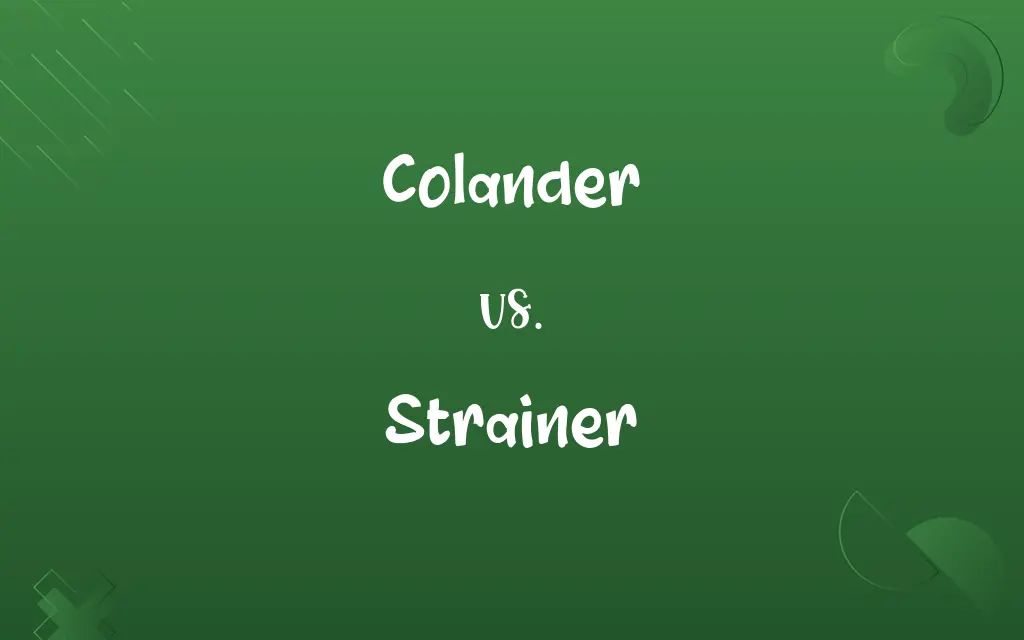Colander vs. Strainer: Know the Difference

By Shumaila Saeed || Updated on December 25, 2023
A colander is a bowl-shaped kitchen utensil with holes for draining liquids from foods, whereas a strainer is a device, often mesh-like, used for separating solid matter from liquid.

Key Differences
A colander is typically a large, bowl-shaped utensil with perforations, used mainly for draining water from cooked pasta or washed vegetables. Strainers, however, come in various shapes and sizes and are usually made of mesh, designed to filter out finer particles from liquids.
Shumaila Saeed
Nov 29, 2023
Colanders are often made of metal or plastic and have larger holes, making them less suitable for straining fine particles. Strainers can be made from finer mesh or cloth, capable of separating small solids from liquids.
Shumaila Saeed
Nov 29, 2023
The design of a colander usually includes a base that allows it to stand alone in a sink. Strainers often have a handle and are designed to be held or supported over a vessel while straining.
Shumaila Saeed
Nov 29, 2023
Colanders are more commonly used for tasks like draining pasta, vegetables, or rinsing rice. Strainers are versatile in the kitchen for tasks like sifting flour, straining tea, or making broth.
Shumaila Saeed
Nov 29, 2023
In culinary terms, a colander is a specific type of strainer with particular characteristics, while the term strainer encompasses a broader range of filtering tools including colanders.
Shumaila Saeed
Nov 29, 2023
ADVERTISEMENT
Comparison Chart
Design
Bowl-shaped with larger holes
Varies, often mesh-like for finer filtering
Shumaila Saeed
Nov 29, 2023
Typical Use
Draining pasta, vegetables
Straining tea, sifting flour, making broth
Shumaila Saeed
Nov 29, 2023
Size of Particles Filtered
Larger particles, like pasta
Smaller particles, like tea leaves or flour
Shumaila Saeed
Nov 29, 2023
ADVERTISEMENT
Colander and Strainer Definitions
Colander
A bowl-shaped kitchen utensil with holes for draining liquids.
She used a colander to drain the spaghetti.
Shumaila Saeed
Nov 22, 2023
Strainer
A mesh-like tool for filtering finer particles.
Sift the flour using a fine strainer.
Shumaila Saeed
Nov 22, 2023
Colander
A kitchen tool for separating solids from liquids in larger chunks.
Place the potatoes in a colander to cool.
Shumaila Saeed
Nov 22, 2023
Strainer
A device used for separating solid matter from a liquid.
He poured the tea through a strainer.
Shumaila Saeed
Nov 22, 2023
Colander
A perforated bowl for washing or draining food.
Rinse the berries in a colander.
Shumaila Saeed
Nov 22, 2023
ADVERTISEMENT
Strainer
A tool for making broths or teas by separating solids from liquids.
She used a strainer to make the chicken broth clear.
Shumaila Saeed
Nov 22, 2023
Colander
A large and typically metal or plastic utensil with a base.
The colander stood in the sink, full of steamed vegetables.
Shumaila Saeed
Nov 22, 2023
Strainer
One that strains, as a device used to separate liquids from solids.
Shumaila Saeed
Oct 19, 2023
Colander
A device used in food preparation, not for fine straining.
She shook the colander to remove excess water from the lettuce.
Shumaila Saeed
Nov 22, 2023
Strainer
A standing or fallen tree whose branches are partly submerged in a fast-flowing river, presenting a hazard to navigation or to swimmers.
Shumaila Saeed
Oct 19, 2023
Colander
A bowl-shaped kitchen utensil with perforations for draining off liquids and rinsing food.
Shumaila Saeed
Oct 19, 2023
Colander
A bowl-shaped kitchen utensil with holes in it used for draining food that has been cooking in water, such as pasta.
Shumaila Saeed
Oct 19, 2023
Strainer
A device through which a liquid is passed for purification, filtering or separation from solid matter; anything (including a screen or a cloth) used to strain a liquid.
Shumaila Saeed
Oct 19, 2023
Colander
A utensil with a bottom perforated with little holes for straining liquids, mashed vegetable pulp, etc.; a strainer of wickerwork, perforated metal, or the like.
Shumaila Saeed
Oct 19, 2023
Strainer
A perforated screen or openwork (usually at the end of a suction pipe of a pump), used to prevent solid bodies from mixing in a liquid stream or flowline.
Shumaila Saeed
Oct 19, 2023
Strainer
That through which any liquid is passed for purification or to separate it from solid matter; anything, as a screen or a cloth, used to strain a liquid; a device of the character of a sieve or of a filter; specifically, an openwork or perforated screen, as for the end of the suction pipe of a pump, to prevent large solid bodies from entering with a liquid.
Shumaila Saeed
Oct 19, 2023
Strainer
A filter to retain larger pieces while smaller pieces and liquids pass through
Shumaila Saeed
Oct 19, 2023
Strainer
A kitchen utensil, often with a handle, for straining substances.
Use a strainer to rinse the quinoa.
Shumaila Saeed
Nov 22, 2023
Strainer
A versatile tool for various straining needs in cooking.
The strainer is essential for preparing smooth sauces.
Shumaila Saeed
Nov 22, 2023
Repeatedly Asked Queries
Is a strainer the same as a sieve?
A strainer is similar to a sieve but may have a finer mesh.
Shumaila Saeed
Nov 29, 2023
Can a colander be used for rice?
Yes, a colander can be used to rinse or drain rice.
Shumaila Saeed
Nov 29, 2023
Is a colander good for straining tea?
No, a finer mesh strainer is better for tea.
Shumaila Saeed
Nov 29, 2023
What is the purpose of the feet or legs on some colanders?
The feet or legs on colanders are designed to elevate them above the sink or countertop, allowing better drainage.
Shumaila Saeed
Nov 29, 2023
Are there colanders with handles for easy use?
Yes, many colanders come with handles or grips to make them easier to hold and maneuver.
Shumaila Saeed
Nov 29, 2023
Can you strain pasta sauce with a strainer?
Yes, a strainer can be used to remove lumps or solids from pasta sauce.
Shumaila Saeed
Nov 29, 2023
Are colanders only made of metal?
No, colanders can also be made of plastic.
Shumaila Saeed
Nov 29, 2023
Can I use a strainer for pasta?
Yes, but a colander is usually more convenient for pasta.
Shumaila Saeed
Nov 29, 2023
Can you use a colander for washing fruits and vegetables?
Yes, colanders are suitable for rinsing and washing fruits and vegetables.
Shumaila Saeed
Nov 29, 2023
Can strainers be used for sifting tea leaves or herbs?
Yes, fine-mesh strainers are often used for steeping tea or straining herbs from liquids.
Shumaila Saeed
Nov 29, 2023
Are colanders microwave-safe?
It depends on the material; some colanders are microwave-safe, while others are not.
Shumaila Saeed
Nov 29, 2023
Are strainers dishwasher-safe?
Many strainers are dishwasher-safe, but it's essential to check the manufacturer's instructions.
Shumaila Saeed
Nov 29, 2023
What is the cleaning process for a strainer?
Strainers are typically cleaned by rinsing them with water and occasionally using a brush to remove trapped particles.
Shumaila Saeed
Nov 29, 2023
What sizes do colanders come in?
Colanders come in various sizes, from small handheld ones to large, bowl-sized colanders.
Shumaila Saeed
Nov 29, 2023
How do you clean a colander?
Colanders are usually cleaned by rinsing them with water or placing them in a dishwasher.
Shumaila Saeed
Nov 29, 2023
Can colanders be used for draining hot liquids?
Yes, colanders can be used for draining hot liquids, such as pasta water.
Shumaila Saeed
Nov 29, 2023
What is the main difference between a colander and a strainer?
The main difference is the size of the holes or mesh. Colanders have larger holes and are used for draining, while strainers have finer mesh and are used for fine straining.
Shumaila Saeed
Nov 29, 2023
Are there handheld strainers and larger ones for different tasks?
Yes, there are handheld strainers for small tasks and larger ones for more extensive straining.
Shumaila Saeed
Nov 29, 2023
Share this page
Link for your blog / website
HTML
Link to share via messenger
About Author
Written by
Shumaila SaeedShumaila Saeed, an expert content creator with 6 years of experience, specializes in distilling complex topics into easily digestible comparisons, shining a light on the nuances that both inform and educate readers with clarity and accuracy.









































































